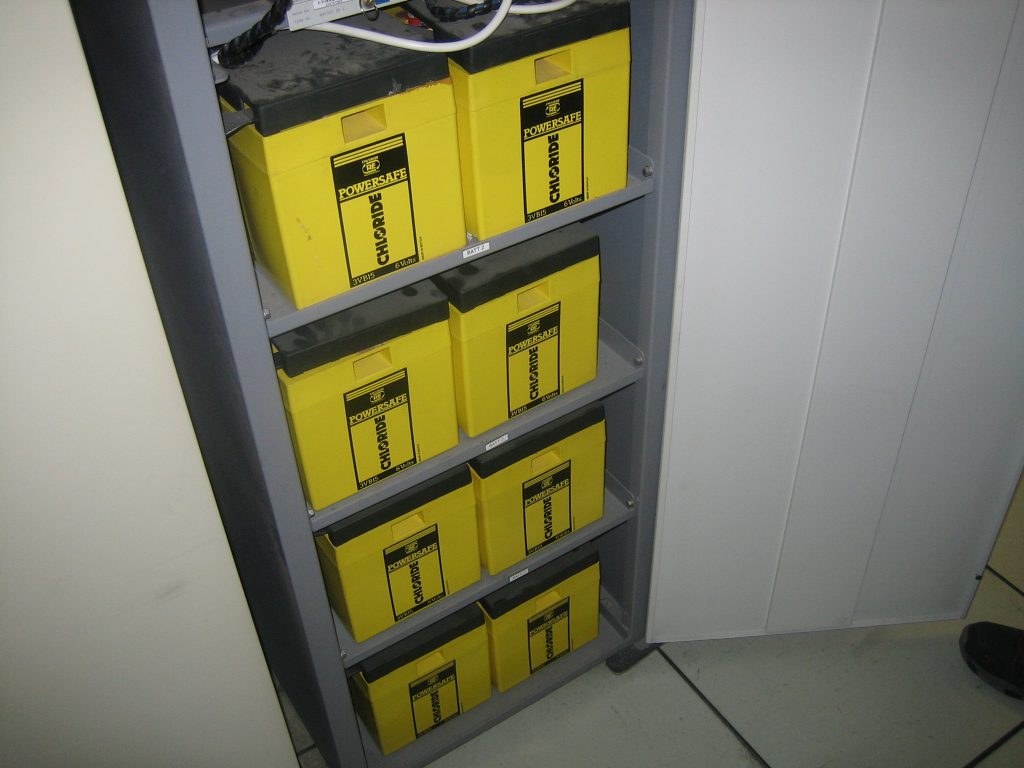UPS Battery recycling has been part of our phone system recycling activities since 1999. Large phone systems such as Siemens Realitis, iSDX, Meridian Option 61 and 81 are typically protected by large banks of car-sized lead-acid back-up batteries. They are usually installed in a dedicated “power cabinet”.
Good news!
UPS battery recycling is something of a recycling success story. Typically over 90% of waste back-up batteries are processed and turned back into errm. …well…..batteries again!
Bad News…
By law, they require special handling, documentation and disposal. They are classed by The Environment Agency as hazardous waste.
More Bad News.
They can kill you. When connected in series in a 16-unit cabinet, they have enough combined current to power an heavy duty industrial electric motor, around 400AH. (around 30 times your mains current, but lethal DC, of course.) Even when assumed discharged, they have to be handled with appropriate tools and personal protective equipment. (Ask us how we know…) We could show you what this current does to a spanner. We keep the burnt item as a warning to ourselves.
Typically, they are lead-acid-gel in type.There’s no nasty liquid acid sloshing about. However, specialist spill kits need to be on hand, and a full method statement and risk assessment issued. You’ll need decent wheeled equipment to move them out of the building.
Back to The Good News.
We can take care of every aspect of removal and disposal due to our unique skill set gained from much experience in removing and recycling large PABX, such as the Siemens Realitis .
Now, a typical scrap merchant would love to just pick them up on a pallet. However, they should not be let loose in your server room to disconnect them. They are unlikely to know what to do. Or want to do it.
Furthermore, the average comms/IT manager or site electrician will have a rough idea on how to disconnect them. However, they would not be equipped for the manual handling, safe working procedures, and disposal.
We have developed an odd combination of skills that covers all aspects of their disconnection, removal, documentation, and recycling. Finally, as there’s often some value in them, this can partly offset any labour and transport costs involved.
More Insights Into Secret Lives
If you’re interested, please read on about their “secret life”. As time goes on, the terminals can develop the most spectacular effects… (illustrated) if not looked after.
Their sides can begin to distort, changing the dead-straight sides into the curves of a pregnant guinea pig. Plastic cases go very brittle indeed, pieces flying off like shrapnel if damaged. They also adhere to shelves, and also to each other. At around 25-30 Kgs each, they are heavy. Very heavy. A typical 16-cell stack is close to half a tonne. We always try to use wheeled equipment, but occasionally we’ve had to lug them out of tight corners by sheer grunt and sweat.
The End/The Beginning
We’re never sad to see them unloaded at our specialist, Environment Agency Accredited processor. However, we are cheered up by the fact that over 90% of their content is recycled.
Meanwhile, At A Domestic Wheelie Bin Near You…
UPS Battery recycling – it’s a green success story., Watch how this is done here. However, compare and contrast with the tonnes of nickel-cadmium domestic “AA” batteries simply tossed into domestic waste each year. One of the classic paradoxes of recycling; Joe Public can get away with doing naughty things with waste that most of us recycling professionals would be prosecuted over.
Can We Help You?
Oh, and we’ve handled smaller UPS equipment, too. So if you have a quantity of these for removal and disposal/recycling, we do UPS Battery recycling properly. Don’t try and lift them yourselves, by the way. Let us do it. Drop us a line…




Very interesting recycling processes. The video you published shows a company based in USA. What about the UK, Europe? Who is recycling batteries? We see a lot of battery recycling points in supermarkets, but little do we know about where it goes and who makes money from the recovered material. And since the customer bought the original product, shouldn’t they get a share of the profit too?
Well, the process for lead-acid batteries will be the same worldwide.
Regarding the smaller , Ni-Cad and Ni-Mh batteries, these are significantly different to lead-acid ones, and my impression is that the process is more complex and less commercially rewarding. I don’t think that there’s much to pass back to the consumer, and the main issue is to at least get some reusable content from them, and, above all, keep them from landfill. They really are nasty little things, with lots of pollutants.
Thanks for your comments!